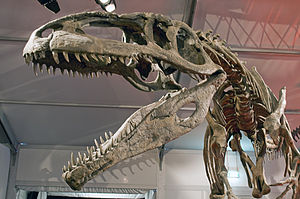Carcharodontosauridae
| Carcharodontosauridae | ||||||||||||
|---|---|---|---|---|---|---|---|---|---|---|---|---|

Skeleton reconstruction of Giganotosaurus |
||||||||||||
| Temporal occurrence | ||||||||||||
| Lower to Upper Cretaceous ( Barremium to Turonium ) | ||||||||||||
| 130.7 to 89.7 million years | ||||||||||||
| Locations | ||||||||||||
| Systematics | ||||||||||||
|
||||||||||||
| Scientific name | ||||||||||||
| Carcharodontosauridae | ||||||||||||
| Stromer , 1931 |
The Carcharodontosauridae (from gr. Καρχαροδοντόσαυρος, toothed lizards or shark tooth lizards ) are a family group ( taxon ) of large theropods that first appeared in the Lower Cretaceous and are closely related to the allosaurids . It was first defined by Ernst Stromer in 1931.
They include the largest predatory dinosaurs known to date, such as the two South American genera Giganotosaurus with a length of more than 13 meters and Mapusaurus (approx. 12.2 meters) or Carcharodontosaurus from Africa, which is up to 13.5 meters in length could have achieved. The fossil record of the carcharodontosaurids extends over a period of over 40 million years (131 to 89 mya ). The Carcharodontosauriden mainly spread on the Urcontinent Gondwana , but also had representatives in North America ( Acrocanthosaurus ), Europe ( Concavenator ) and Asia ( Shaochilong ).
features
They reached or exceeded the body size of the tyrannosaurids and are therefore considered to be one of the largest land carnivores on earth. Their skulls could be up to 1.6 meters long. Despite their size, they were lighter than, for example, allosaurids or tyrannosaurids of the same size. They had a sturdy build, yet were agile.
Systematics
External system
The Carcharodontosauridae are considered to be a very advanced group of the Allosauriden. They are often shown as sister taxons of the Neovenatoridae ; both are combined to form the Carcharodontosauria . The following cladogram shows the external systematics according to Benson et al. (2010):
| Allosauroidea |
|
||||||||||||||||||
|
|
Internal system
The family of Carcharodontosauridae was originally named by Ernst Stromer in order to incorporate the species Carcharodontosaurus saharicus , which he had recently discovered, into the Theropoda . When Giganotosaurus was described in 1995 , it was also classified in the family. With the discovery of Mapusaurus in 2006, Rodolfo Coria and Phil Currie defined the subfamily Giganotosaurinae , which includes Giganotosaurus and Mapusaurus and separates these two genera from the rest of the Carchadontosauriden.
In 1998 Paul Sereno defined the Carcharodontosauridae as a clade that includes Carcharodontosaurus and all genera more closely related to Carcharodontosaurus than to Allosaurus , Sinraptor , Monolophosaurus or Cryolophosaurus .
The Brusatte et al. (2009) clarifies the internal systematics of the Carcharodontosauridae, whereby it should be mentioned here that Neovenator has been placed outside the Carcharodontosauridae, namely in the Neovenatoridae , in recent studies :
| Carcharodontosauridae |
|
|||||||||||||||||||||||||||||||||||||||
|
|
Individual evidence
- ^ Gregory S. Paul : The Princeton Field Guide To Dinosaurs. Princeton University Press, Princeton NJ et al. 2010, ISBN 978-0-691-13720-9 , pp. 97-98, online ( memento of the original of July 13, 2015 in the Internet Archive ) Info: The archive link was inserted automatically and not yet checked. Please check the original and archive link according to the instructions and then remove this notice. .
- ↑ a b Stephen L. Brusatte, Roger BJ Benson, Daniel J. Chure, Xing Xu , Corwin Sullivan, David WE Hone: The first definitive carcharodontosaurid (Dinosauria: Theropoda) from Asia and the delayed ascent of tyrannosaurids. In: The natural sciences . Vol. 96, No. 9, 2009, pp. 1051-1058, doi : 10.1007 / s00114-009-0565-2 .
- ↑ Michael J. Benton : Paleontology of the vertebrates. Translation of the 3rd English edition by Hans-Ulrich Pfretzschner. Pfeil, Munich 2007, ISBN 3-89937-072-4 .
- ↑ Eric Snively, Anthony P. Russell: Kinematic Model of Tyrannosaurid (Dinosauria: Theropoda) Arctometatarsus Function. In: Journal of Morphology. Vol. 255, No. 2, 2003, pp. 215–227, doi : 10.1002 / jmor.10059 , digitized version (PDF; 551 kB) ( Memento of the original from September 24, 2015 in the Internet Archive ) Info: The archive link became automatic used and not yet tested. Please check the original and archive link according to the instructions and then remove this notice. .
- ^ A b Roger BJ Benson, Matthew T. Carrano, Stephen L. Brusatte: A new clade of archaic large-bodied predatory dinosaurs (Theropoda: Allosauroidea) that survived to the latest Mesozoic. In: Natural Sciences . Vol. 97, No. 1, 2010, pp. 71-78, doi : 10.1007 / s00114-009-0614-x , PMID 19826771 , bibcode : 2010NW ..... 97 ... 71B .
- ↑ Rodolfo A. Coria , Philip J. Currie : A new carcharodontosaurid (Dinosauria, Theropoda) from the Upper Cretaceous of Argentina. In: Geodiversitas. Vol. 28, No. 1, 2006, ISSN 1280-9659 , pp. 71-118, digitized version (PDF; 2.9 MB) .
Web links
- The Paleobiology Database Carcharodontosauridae

